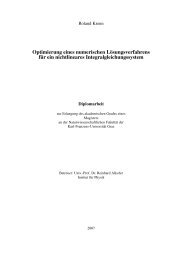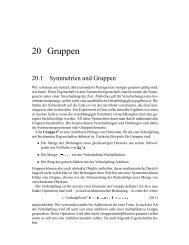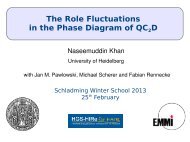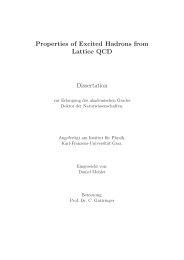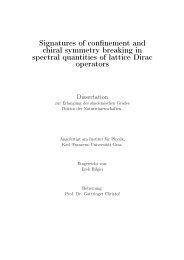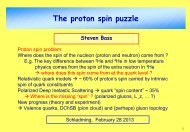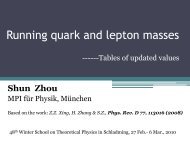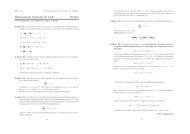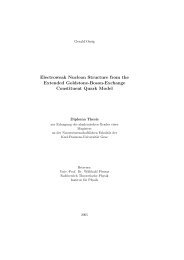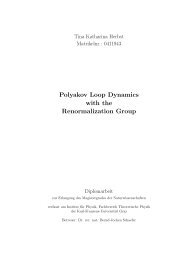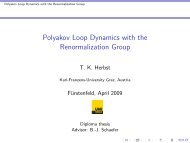The QCD Quark Propagator in Coulomb Gauge and - Institut für Physik
The QCD Quark Propagator in Coulomb Gauge and - Institut für Physik
The QCD Quark Propagator in Coulomb Gauge and - Institut für Physik
You also want an ePaper? Increase the reach of your titles
YUMPU automatically turns print PDFs into web optimized ePapers that Google loves.
50<br />
we obta<strong>in</strong> three coupled <strong>in</strong>tegral equations for Γ p , Γ A <strong>and</strong> Γ T . For a conf<strong>in</strong><strong>in</strong>g potential<br />
these quantities also diverge. We therefore <strong>in</strong>troduce<br />
h(|p|) = Γ p(|p|)<br />
ω(|p|)<br />
(5.8)<br />
<strong>and</strong><br />
where<br />
g(|p|) = Γ p(|p|) + 2B(|p|)Γ A (|p|) + 2|p|C(|p|)Γ T (|p|)<br />
ω 2 (|p|) − m 2 π /4 , (5.9)<br />
ω(|p|) = √ B 2 (|p|) + |p| 2 C 2 (|p|) . (5.10)<br />
<strong>The</strong> functions h(|p|) <strong>and</strong> g(|p|) are f<strong>in</strong>ite <strong>and</strong> satisfy the coupled <strong>in</strong>tegral equations<br />
h(|p|)ω(|p|) = 1 ∫ [<br />
]<br />
d 3 qV<br />
3π 2 C (k) h(|q|) +<br />
m2 π<br />
4ω(|q|) g(|q|) [ ]<br />
g(|p|) ω(|p|) −<br />
m2 π<br />
= h(|p|)+<br />
ω(|p|)<br />
∫<br />
1<br />
d 3 V C (|k|)<br />
q (M(|p|)M(|q|) + (ˆpˆq)|p||q|)g(|q|) , (5.11)<br />
3π 2 ˜ω(|p|)˜ω(|q|)<br />
where we <strong>in</strong>troduced<br />
˜ω(|p|) = √ M 2 (|p|) + p 2 . (5.12)<br />
For vector mesons (<strong>and</strong> correspond<strong>in</strong>gly axial-vector diquarks) the Bethe-Salpeter vertex<br />
function has four l<strong>in</strong>early <strong>in</strong>dependent amplitudes. <strong>The</strong> construction of the four coupled<br />
<strong>in</strong>tegral equations correspond<strong>in</strong>g to the BSE is analogous to the pseudoscalar case.<br />
<strong>The</strong> homogeneous BSE <strong>in</strong> equation (5.6) can be solved by <strong>in</strong>troduc<strong>in</strong>g an eigenvalue<br />
λ(P 2 = M 2 ) with M the bound-state mass. One then f<strong>in</strong>ds M such that λ = 1 for mesons<br />
<strong>and</strong> λ = 2 for diquarks. <strong>The</strong> numerical solution of the BSEs can be performed as <strong>in</strong><br />
[OVSA02].<br />
We studie the Bethe-Salpeter amplitudes as µ IR → 0: the results for g <strong>and</strong> h of<br />
(5.11) are presented <strong>in</strong> figs. 5.2 <strong>and</strong> 5.3 for the pion <strong>and</strong> scalar diquark, respectively. For<br />
convenience, the normalisation of the amplitudes has been chosen such that h(0) = 1. We<br />
note, however, that IR-cancellations appear<strong>in</strong>g <strong>in</strong> the pion case lead to a stable h as well<br />
as ratio of g/h, which is not the case (as one would naively expect) <strong>in</strong> the diquark case:<br />
there g/h ∼ µ IR → 0 <strong>and</strong> h ∼ 1/ √ µ IR .<br />
<strong>The</strong> curve for λ(P 2 ) gets less <strong>in</strong>cl<strong>in</strong>ed with smaller values of the <strong>in</strong>frared regulator µ IR ,<br />
<strong>and</strong> its <strong>in</strong>tersection po<strong>in</strong>t with λ = 1 stabilises <strong>in</strong> the limit µ IR → 0. As a consequence,<br />
while the meson mass is stable, the mass eigenvalue for the correspond<strong>in</strong>g diquark state<br />
(correspond<strong>in</strong>g to λ(M) = 2) <strong>in</strong>creases like 1/µ IR , ultimately completely remov<strong>in</strong>g these



